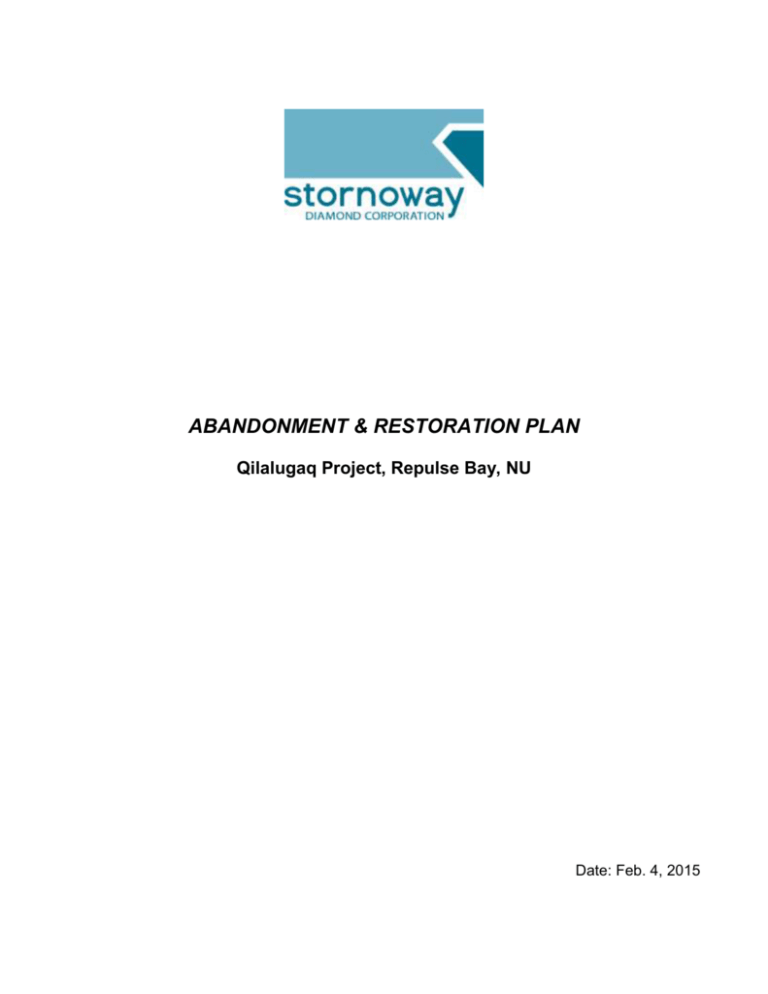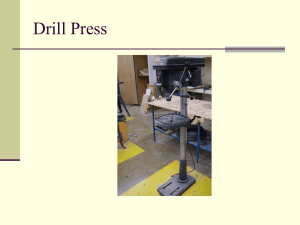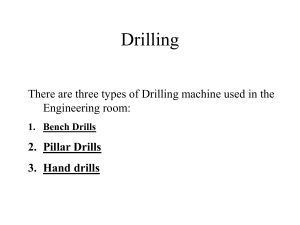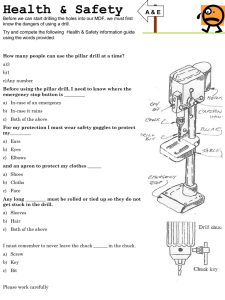150219-12EN012-Abandonment-Restoration Plan
advertisement

ABANDONMENT & RESTORATION PLAN Qilalugaq Project, Repulse Bay, NU Date: Feb. 4, 2015 TABLE OF CONTENTS Page 1.0 INTRODUCTION – Purpose and Scope ...................................... 1 1.1 Description of Diamond Drilling.......................................................... 2 2.0 ONGOING OPERATIONS, SEASONAL ABANDONMENT, FINAL ABANDONMENT AND RESTORATION PLANS……...……………..2 2.1 ONGOING OPERATIONS ..................................................................... 2 2.1.1 Drill Hole Locations .................................................................. 3 2.1.2 Core Storage ............................................................................ 3 2.1.3 Fuel Storage ............................................................................. 3 2.1.4 Contamination Clean Up .......................................................... 3 2.2 SEASONAL ABANDONMENT AND RECLAMATION ......................... 3 2.2.1 Drill Hole Locations .................................................................. 4 2.2.2 Fuel Storage ............................................................................. 4 2.3 FINAL ABANDONMENT AND RECLAMATION…………………………4 LIST OF FIGURES Figure 1: Fuel Storage Location in Repulse Bay ................................................... 5 Figure 2: Qilalugaq Property Location and Proposed Work Area Map .................. 6 1.0 INTRODUCTION The following Abandonment and Restoration Plan applies to the Qilalugaq Project (the “Project”) in Nunavut which is operated by North Arrow Minerals Inc. (“North Arrow”) under a joint venture option agreement with the proponent, Stornoway Diamond Corp. (“Stornoway”). The land use activity associated with the Plan is a diamond and RC drill program which will produce approximately 10,000-15,000 m of drill core from the Q1-4 Kimberlite Complex. The Qilalugaq Property (the “Property”) is located approximately 10 km outside of the hamlet of Repulse Bay and takes about five to seven minutes to reach via helicopter. The proposed land use activity will be conducted during the months of July and August in the summer of 2015 and last for approximately 10-20 weeks. A winter 2016 drilling component is also being considered as follow-up to the summer drilling program to take advantage of on-ice drilling. The timing and execution of the proposed drill programs are dependent upon weather, logistics and resources. The Project is located in the north Kivalliq Region of Nunavut. The Property sits on municipal land, regulated by the Department of Community and Government Services, and is designated as Commissioner’s Land. Year-round access to the property is via helicopter, quad and snowmachine. The property is bounded in a general sense by the following minimum and maximum latitudes/longitudes: Min Lat (degree/minute) Max Lat (degree/minute) 66° 35’ 22” 66° 35’ 38” Min Long (degree/minute) Max Long (degree/minute) -86° 07’ 50” -86° 07’ 02” North Arrow intends to carry out drilling and archaeological surveying in 2015. Work will be confined to the current lease area (Figure 2). Personnel for the program will include a five member drill crew, two to three geologists, one archaeologist, one helicopter pilot, one engineer and one cook/first aid attendant. Due to the proximity of the Project area to Repulse Bay, camp facilities will not be required at this time as all personnel will stay in the Hamlet. A small, temporary facility will be built at the Project site for core logging and preparation. Following logging, drill core will be slung via helicopter to a yet to be determined site in Repulse Bay for preparation to be shipped south for processing. Core logging personnel will be transported to and from the land use area at the beginning and end of each shift. Fuel for the program will be stored in Repulse Bay at a predetermined and authorized by the Hamlet site where the drums could be temporarily stored in a fuel storage berm for the duration of the land use program (Figure 1). Should any changes be made to the procedures described herein or the scope of the project in general, the Plan will be revised immediately to reflect such changes and the revision will be submitted to the requisite regulatory agencies as soon as is practicable. 1 1.1 DESCRIPTION OF DIAMOND DRILLING Locations – Fuel stored at the drill site will be kept a safe distance (>31m) from the high water mark of local water bodies. Size – During the summer, the drill will be a light-weight heli-portable model for quick dismantling and transport, similar in size and specifications to a Discovery 1 Diamond Core Drill. During the winter, the drill will be mounted on skids which will allow it to be dragged from drill hole to drill hole. Storage Capacity – A minor amount of fuel will be stored at drill sites (4 to 6 drums diesel, 1 drum Jet A/B), and removed promptly upon completion of each drill hole. Description of the type and amount of potential contaminants normally stored at drill site: JET A/B fuel for the helicopter – 205 litres (1 drum) Diesel for the drill - 1,230 litres (6 drums) Engine Oil 5-20 litres Antifreeze 5-20 litres Drilling Muds/Greases 5-20 litres Drilling Salt 10-20 lb. bags Storage Location - Drums will be stored on flat, stable terrain with secondary containment berms during the program to reduce chances of a leak. If possible, a site will be chosen such that drainage would not be toward natural water bodies. The small supply of engine oil, antifreeze and drilling muds/greases that will be kept at the drill site will be stored in 5-20 liter, plastic, lidded storage containers, proximal to absorbent matting at all times. Salt will be stored in the hamlet in 10-20lb bags and transported to the drill as needed. One lead acid battery will be used at the drill with spares stored in the hamlet. Spill kits will be located wherever fuel and hazardous material are stored. 2.0 ONGOING OPERATIONS, SEASONAL ABANDONMENT, FINAL ABANDONMENT AND RESTORATION PLANS 2.1 ONGOING OPERATIONS The exploration season for the Qilalugaq Project will typically run from March to the middle of September each year, weather permitting. Restoration during operations for drilling, fuel storage, contamination clean up and camp operations are described below. 2 2.1.1 Drill Hole Locations Each drill hole will be restored to as close as possible to previous conditions after completion of the hole. If a hole is drilled on-ice, the drill cuttings will be captured using a “Polydrill” filter system (or similar) and then deposited into an on-land natural depression or hand-dug sump. All fuel drums and drilling equipment will be removed from the site immediately upon completion of each hole. Each drill site will be inspected to ensure that all garbage (combustible and non-combustible) has been collected and removed from the area. A final inspection of the site will ensure that there is no remaining material at the site upon completion of the drill hole. Before and after photographs will be taken of each drill site. 2.1.2 Core Storage Drill core will either be stored in the field at a centralized location, in town at an appropriate facility, or shipped south. This would be dependent upon the location of drill targets. The location of any core will be indicated in yearly land use reports. 2.1.3 Fuel Storage All fuel storage and handling is to be guided by the procedures set out in the Spill Contingency Plan for the Qilalugaq Project (submitted along with the Abandonment and Reclamation Plan). Empty fuel drums are to be regularly backhauled to town for proper disposal. 2.1.4 Contamination Clean Up Any soil around fuel caches or drill sites that has become contaminated will be treated as per North Arrow’s Spill Contingency Plan. Before and after photos will be taken to document the contamination and clean-up. 2.2 SEASONAL ABANDONMENT & RECLAMATION At the end of the proposed program, all materials, fuel drums and the drill (if required) will be removed from the site. All garbage will be collected and removed and any fuel caches will be inventoried and inspected for any leaks. As work on the properties comprising the Qilalugaq Project is currently still in the planning stages, it is not practical at this time to subscribe to a definitive schedule for the conclusion of this land use operation, however upon its completion the following procedures will be followed to allow for proper abandonment and reclamation of the area: 3 2.2.1 Drill Hole Locations As per the ongoing restoration procedures, all drill holes are to be restored to as close as possible the previous conditions immediately following completion of each hole. Drill casing will be removed following the completion of each drill hole. If unable to remove casing, it will be cut as close to the ground as possible, and the casing flown back to town for proper disposal. All fuel drums and drilling equipment will be removed from the site immediately upon completion of each hole. Each drill site will be inspected to ensure that all garbage (combustible and non-combustible) has been collected and removed from the area. A final inspection of the site will ensure that there is no remaining material at the site upon completion of the drill hole. 2.2.2 Fuel Storage All fuel storage and handling is to be guided by the framework set out in the Spill Contingency Plan for the Qilalugaq Project. Upon completion of the land use operation all empty fuel drums will be removed from the area for proper disposal and any remaining fuel caches will be moved to an approved/permitted storage location. 2.3 FINAL ABANDONMENT AND RESTORATION As the land use activity associated with the Plan may require follow-up drill programs, seasonal abandonment procedures will be followed. Following the completion of the land use program, final abandonment and reclamation activities will take place. All equipment, site infrastructure, site material, fuel and waste will be removed from the area upon completion of the land use operation. Photographs will be taken of the reclaimed areas and the requisite reports detailing the restoration activities performed will be submitted to the applicable regulatory authorities in order to aid their personnel in the final inspection and subsequent closure of the land use operation. 4 5 6






